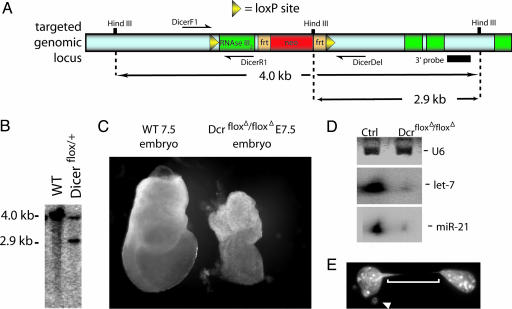Fig. 1.
Construction of a Dicer conditional mouse allele. (A) Schematic of the Dicer conditional targeting construct. (B) Southern blot of correctly targeted embryonic stem cells. By using a 3′ probe, a 2.9-kb fragment is detected in addition to the wild-type 4.0-kb fragment in targeted embryonic stem cells. (C) Upon Cre-mediated recombination of the Dicerflox allele in the germ line, homozygous mutant embryos resemble the reported null allele (15). (D) RNA was extracted from primary fibroblasts from wild-type or Dicerflox/Dicerflox mice. Parallel experiments with GFP adenovirus indicated near 90–100% infection efficiency. The presence of a small amount of processed let-7 and miR-21 RNA in Dicer-null cells may be due to the inclusion of Dicer-positive cells in our RNA preparations or may indicate that a small amount of miRNA processing is independent of Dicer. (E) A representative example of a cell displaying defects in chromosome segregation upon removal of Dicer. The arrowhead points to a micro nucleus, and the brackets indicate an anaphase spindle. Counting the number of anaphase spindles and satellite nuclei present among four randomly chosen fields of DAPI-stained cells revealed that ≈25% of the Dicer-null cells displayed defects in chromosome segregation and accumulation of satellite nuclei despite a normal morphological appearance under the light microscope. In control adeno-GFP-treated cells, 1.4% of the cells contained satellite nuclei but no anaphase bridges.

